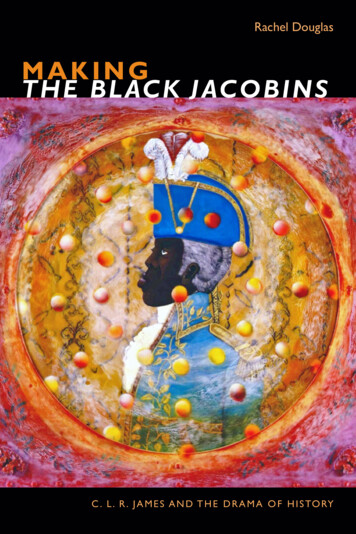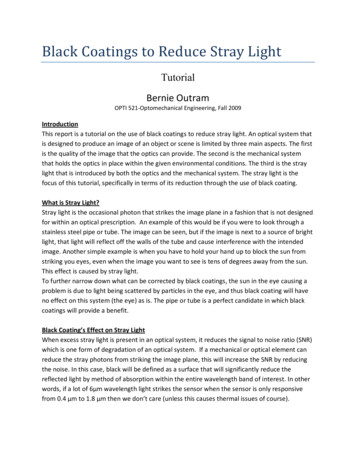
Transcription
Rachel DouglasMAKINGT HE B LACK J AC O B INSC . L . R . J A M E S A N D T H E D R A M A O F H I S TO RY
MAK INGTH E BLACK J ACOB I NS
the c. l. r . james archives
MAKINGTHE BLACK J ACOBINSC. L. R. James and the Drama of History R ACHEL D OUG LASduke university pressdurham and london2019
2019 Duke University PressAll rights reservedPrinted in the United States of Amer ic a on acid- free paper Designed by Amy Ruth BuchananTypeset in Arno Pro and Gill Sans Std.by Westchester Publishing ServicesLibrary of Congress Cataloging- in- Publication DataNames: Douglas, Rachel, [date] author.Title: Making the Black Jacobins : the drama of C. L. R. James’s history / Rachel Douglas.Description: Durham : Duke University Press, 2019. Series:The C. L. R. James archives Includes bibliographical references andindex.Identifiers: lccn 2019002423 (print)lccn 2019009129 (ebook)isbn 9781478005308 (ebook)isbn 9781478004271 (hardcover : alk. paper)isbn 9781478004875 (pbk. : alk. paper)Subjects: lcsh: James, C. L. R. (Cyril Lionel Robert), 1901–1989.Black Jacobins. James, C. L. R. (Cyril Lionel Robert),1901–1989— Criticism and interpretation. Toussaint Louverture,1743–1803. Haiti— History— Revolution, 1791–1804.Classification: lcc F1923 (ebook) lcc f1923 .d684 2019 (print) ddc 972.94/03— dc23lc rec ord available at https:// lccn . loc . gov / 2019002423Cover art: Édouard Duval-Carrié, Le Général Toussaint Enfumé, 2001. Édouard Duval-Carrié. Courtesy of Rum Nazon, Cap Haïtien.
THIS BOOK IS DEDICATED TOCATRIONA AND LEILA
CONTENTSAcknowl edgments ixIntroduction 11Toussaint Louverture Takes Center Stage: The 1930s 292Making History: The Black Jacobins (1938) 693Rewriting History: The Black Jacobins (1963) 1024Reshaping the Past as Drama (1967) 1335Afterlives of The Black Jacobins 178Notes 215Bibliography 265Index 295
ACKNOWL E DGMENTSThis book is based on research conducted in Trinidad and New York fundedby a British Acad emy Small Research Grant (sg-51932) and a Small ResearchGrant from the Car ne gie Trust for the Universities of Scotland. The bookwas written while I was in receipt of an Arts and Humanities Research Council Early- Career Fellowship (ah/I002662/1). I gratefully acknowledge thesupport of the ahrc, the British Acad emy, and the Car ne gie Trust. Duringthe proj ect, I moved to the University of Glasgow from the University ofLiverpool, and I would like to thank colleagues at both institutions for theircontributions, especially Charles Forsdick, Michael Syrotinski, and JackieClarke.In addition to the ahrc and the universities of Glasgow and Liverpool,I am very grateful to the following organ izations for their assistance with theOctober 2013 conference, The Black Jacobins Revisited: Rewriting History:International Slavery Museum, National Museums Liverpool, the Bluecoat,Society for the Study of French History, Association for the Study of Modern and Con temporary France, Society for French Studies, Royal Historical Society, Alliance Française de Glasgow, and the Haiti Support Group.Participants at that event, including the keynote speakers Yvonne Brewster,Selwyn R. Cudjoe, Rawle Gibbons, Robert A. Hill, Selma James, Nick Nesbitt, and Matthew J. Smith, made invaluable contributions to C. L. R. Jamesscholarship t here.This book has been a long time in the making and many p eople have collaborated with me to help bring it to fruition. To each of the following peopleI owe more than I can say, and so let me warmly thank David Abdullah, Michel Acacia, Katie Adams, Foz Allan, Tayo Aluko, Adisa “Aja” Andwele, Yoshio Aoki, A. James Arnold, David Austin, David A. Bailey, Martin Banham, Aisha Baptiste, Carla Bascombe, Madison Smartt Bell, Anthony Bogues,
Sergio Bologna, Yvonne Brewster, Hans- Christoph Buch, Margaret Busby,Jhon Picard Byron, Raj Chetty, Sandro Chignola, Rocky Cotard, SelwynR. Cudjoe, Raphael Dalleo, Claudy Delné, Mike Dibb, Ceri Dingle, FarrukhDhondy, Marilyn Dunn, Natalia Ely, Laurent Dubois, Grant Farred, DavidFeatherstone, Kate Ferris, Charles Forsdick, Maria Cristina Fumagalli, FerruccioGambino, Marvin George, Rawle Gibbons, Corey Gilkes, Maurisa Gordon- Thompson, Katie Gough, Donna Hall- Commissiong, Emma Hart, LeilaHassan, Kathleen Helenese- Paul, Yuko Hirono, Kate Hodgson, Raphael Hoer mann, Christian Høgsbjerg, Sean Jacobs, Selma James, Ulrick Jean- Pierre,Kwynn Johnson, Aaron Kamugisha, Rochelle Kapp, Louise Kimpton- Nye,Kwame Kwei- Armah, Jean- Pierre Le Glaunec, Adrian Leibowitz, HonglingLiang, Rosa López Oceguera, Filippo del Lucchese, Danielle Lyndersay,Roy McCree, Peter D. McDonald, Llewellyn McIntosh (Short Pants),F. Bart Miller, Lukanyo Mnyanda, Sumita Mukherjee, Jenny Morgan, Stephen Mullen, Martin Munro, Philip Murray (Black Sage), Lorraine Nero, NickNesbitt, Aldon Lynn Nielsen, Tadgh O’ Sullivan, Raffaele Petrillo, BryonyRandall, Ciraj Rassool, Alan Rice, David Rudder, Marina Salandy- Brown,Catherine Spencer, Corinne Sandwith, Bill Schwarz, Marika Sherwood,Richard Small, Andy Smith, Matthew J. Smith, Terry Stickland, PatrickSylvain, Glenroy Taitt, Afonso Teixeira Filho, Harclyde Walcott, ElizabethWalcott- Hackshaw, Ozzi Warwick, Zoë Wilcox, and Eugene Williams. Without their generous help, none of this would ever have been pos si ble.Frank Rosengarten, Darcus Howe, and Dapo Adelugba, who all contributed to this proj ect, sadly died before the book was finished. Robert A. Hill,C. L. R. James’s literary executor and close associate, shared his unparalleledextensive knowledge of James’s life and work. After my own two trips to theC. L. R. James Papers archive at Columbia University, New York, JeremyGlick was an enormous help with archival research assistance. There couldnot have been a better- qualified navigator of that archive. I appreciate howquickly he stepped into the breach when some archive photos were lost. I amforever indebted to Rianella Gooding for taking such good photo graphs ofJames’s open- book gravestone in Tunapuna cemetery, Trinidad, for me atshort notice. Very special thanks to three p eople in Barbados— AlissandrawhoCummins, William St. James Cummins, and Anderson Toppin— moved heaven and earth at short notice to take a high- resolution photo ofRas Akyem- i Ramsay’s artwork. Many thanks to the artist Édouard Duval- Carrié, and to the owners Rum Nazon, Cap- Haïtien for allowing me to usethe 2001 portrait of Le Général Toussaint enfumé (General Toussaint wreathedx Acknowl edgments
in smoke) for the cover. This directly James- inspired artwork reclaims TheBlack Jacobins for the land of its inspiration: Haiti. Warm thanks also go toRamsay, Kimathi Donkor, Lubaina Himid, and the Middlesbrough Instituteof Modern Art for granting me permission to reproduce their artworks in thefollowing pages.Most of the actual writing of this book happened at the National Libraryof Scotland, Edinburgh. Staff there and at the interlibrary loans departmentat Glasgow University Library were very efficient and enabled me to accessmany rare documents. Librarians and archivists from around the world haveprovided me with an abundance of rare materials about C. L. R. James. Iwould particularly like to thank staff in special collections departments atthe University of the West Indies, St. Augustine, Trinidad; Columbia University, New York; the Walter P. Reuther Library of Wayne State University,Detroit, Michigan; the Tamiment Library of New York University Libraryand the Oral History of the American Left materials set up by Paul Buhleand Jonathan Bloom; the Schomburg Center for Research in Black Culture in New York City; the Penn State University Libraries; the Moorland- Spingarn Research Center at Howard University, Washington, DC; the ErrolHill Papers at Dartmouth College, New Hampshire; the Richard WrightPapers at the Beinecke Library, Yale University; the Sir Learie ConstantineCollection, National Library Information Ser vices (nalis), Trinidad; theAndrew Salkey Archive, British Library; the Quinton O’Connor MemorialLibrary, Oilfield Workers’ Trade Union (owtu), San Fernando, Trinidad;the Institute of Commonwealth Studies, Senate House Library, Universityof London; Glasgow Caledonian University Archive of the Trotskyist Tradition, Glasgow; the Talawa Theatre Com pany Papers at the Victoria andAlbert Theatre and Per for mance Archives, London; and the L abour HistoryArchive and Study Centre, Manchester.Thanks to editor Gisela Concepción Fosado and to every one at DukeUniversity Press for their support. I am grateful to the readers for their incisive and thought- provoking comments. A dif fer ent version of sections ofchapter 4 appeared in The Black Jacobins Reader, edited by Charles Forsdickand Christian Høgsbjerg (2017). I acknowledge the permission given by theeditors and Duke University Press to draw on the material in the context ofthis broader analy sis.I would like to thank my family, especially Stephen—my first reader— who has been so supportive of this proj ect, who has lived with the book fora long time, and who has gone out of his way to help at every stage of theAcknowl edgments xi
pro cess. This book is dedicated to Catriona and Leila, who arrived duringthe book’s making. Both have been very patient while I have been workingon the mysterious book. They both prob ably know a great deal now aboutC. L. R. James, The Black Jacobins, and the Haitian Revolution, as these weresubjects of conversation in our h ouse for so long. Their drawings and doodles often adorned many of the pages as I was writing them. I hope that oneday soon they too will read and discover The Black Jacobins for themselves.xii Acknowl edgments
INTRODUCTION ere is no drama like the drama of history.Th— C. L. R. James, The Black JacobinsIf there is no drama like the drama of history, according to C. L. R. Jameshimself, what was the role of actual drama in shaping his own accounts ofthe Haitian Revolution across versions of The Black Jacobins? This questionguides the pre sent book, which takes James’s own repre sen ta tion of the pastof the Haitian Revolution as drama into account by examining both hisplays, Toussaint Louverture in 1936 and The Black Jacobins in 1967. Clichésabout links between drama and history abound. References to the drama ofhistory, the great drama of a revolution, and descriptions of historical characters as tragic protagonists on the stage of world history are commonplace.Publisher Secker and Warburg’s 1938 advertisement for The Black Jacobinsreferred once to “romance” and twice to “drama”: “The romance of a g reat career and the drama of revolutionary history are combined in clr james’magnificent biography of toussaint louverture. [ . . . ] The drama ofhis career is here brilliantly described in a narrative which grips the attention.”1 But beyond such analogies where historical events can be said to resemble drama, what happens when the past is actually turned into drama?Making The Black Jacobins: C. L. R. James and the Drama of History chartsthe trajectory of C. L. R. James’s multiple engagements with the HaitianRevolution throughout his lifetime, including his pioneering history TheBlack Jacobins. By uncovering the mobile and organic transformations ofThe Black Jacobins in both its theatrical and historiographical versions, thisbook illuminates the genesis and evolution of James’s Haitian Revolution– related writing over a period of almost sixty years, from the 1930s to hisdeath in 1989. The Black Jacobins is shown in chapter 5 on f uture directions to
have lived on in a series of afterlives where o thers have made the work speakto new circumstances and issues in their turn.The Black Jacobins is one of the great works of the twentieth century andremains today the cornerstone of Haitian Revolutionary studies. Making TheBlack Jacobins investigates the complex transformations through which thework came to be, via the first comparisons of the two plays and two versionsof the history, while taking the reader on a tour of the significant paratexts— book covers, interviews, talks, and reviews— that document the work’s multiple becomings. This book investigates the vital significance of The BlackJacobins as a work of history and of theater by bringing the revisions andtheir meanings to the attention of general readers of James. It is based ondiscussion of hitherto all but completely neglected manuscripts of James’sfirst and second plays, and his correspondence about t hese plays and historyeditions, together with special attention to the ways in which James rewroteand rethought The Black Jacobins history over the course of his life in manydif fer ent contexts and periods. The book surveys for the first time in its entirety the history of James’s masterpiece and its transformations as historyand play. As a whole, Making The Black Jacobins compares and contrasts thechanging historiographic narrative with the relative freedom of theater to refashion understanding of the revolution, in the absence of any conclusivedocumentation in the historical archive.Despite its importance as the classic history of the Haitian Revolution, there is relatively l ittle knowledge of the eventful history of The Black Jacobins itself, and of key changes made by James and others, both duringand after the author’s lifetime. Rewriting— the subject of this book— linksJames’s topic, his writing methods, and the events of the Haitian Revolution.James’s history helped to change the way colonial history was written frompresenting the colonized as passive objects to active subjects. Added to this,James kept telling and retelling how the Haitian Revolution rewrote worldhistory as the first and only slave revolution to fight against the great powersof the day and win.Rewriting, it will be argued, is an impor tant part of James’s working methods from the beginning and throughout his w hole c areer. James’s other earlyrewritten works include The Life of Captain Cipriani (1932) and The Case forWest Indian Self- Government (1933), with the condensed latter title cuttingout most of the biographical material about the Trinidad labor leader Cipriani.2 Mari ners, Renegades, and Castaways: The Story of Herman Melville andthe World We Live In (1953) was first privately published by James in a bid to2 Introduction
appeal against deportation from the United States, with a copy sent to e verymember of Congress. Its evolution saw James rewrite one chapter and cutout another.3 James also rewrote A History of Negro Revolt, first published in1938, publishing it again in 1969 with a new title— A History of Pan- AfricanRevolt— and an extra epilogue, focusing like the 1963 Black Jacobins historyrevisions on bringing the 1938 history up to date.4 Other slight changes weremade to that text when James was revising it, including the removal of refer ere also occasions when not aences to Franco’s Moors.5 However, t here wsingle word was changed. World Revolution, for example, was first publishedin 1937 and later reprinted unchanged in 1973.6 Another updated statementwas James’s pamphlet State Capitalism and World Revolution, which wentthrough four editions during James’s lifetime: 1950, 1956, 1968, and 1984.7 Inthis way, other works too, beyond The Black Jacobins, were reshaped by Jamesduring his lifetime and reframed in order to respond to new circumstancesacross the world.This book is about the nature and significance of changes throughoutJames’s Haitian Revolution writings from the 1930s up to his death in 1989,and beyond. James was, above all, a profoundly po liti cal person. In a 1980interview, he said he wanted to be remembered as one of the impor tantMarxists for his serious contributions to Marxism.8 This book examineswhat happens as James keeps traveling further along the road of The Black Jacobins in his Haiti- related writing. From the start, James’s writings about theHaitian Revolution can be thought of as reworking Marxism and Trotsky’snotion of permanent revolution. Examining James’s Haiti- related writings,the book reads the changes as reflections of James’s own po liti cal evolution.It is productive to think of the dif fer ent history editions, plays, and articlesas drafts or working documents, offered up for discussion and further elaboration by James’s po liti cal groups. Looking at what changes over time alsoallows us to chart James’s serious and original contributions to Marxismthrough the prism of his Haiti- related works.The Black Jacobins must be read alongside James’s defining po liti cal experiences and the great strides in terms of Marxist theory and practice made inAmer i ca from the 1940s onward. U nder the pseudonym J. R. Johnson, Jameswas organ izing a po liti cal group in the United States from the early 1940sonward, which became known as the Johnson- Forest Tendency. This wasformed of a small core, including Raya Dunayevskaya, originally from Rus sia,one of Trotsky’s secretaries, and whose pseudonym “Freddie Forest” becamepart of the group’s name. Th ere was also Grace Lee, a Chinese American whoIntroduction 3
had studied German and helped the group to study Marx’s writings from theoriginal German, while Dunayevskaya enabled them to study other Marxistworks from the original Rus sian.9 Increasingly, James and his group drew attention to the spontaneous self- activity of the masses and to more popu laralternative leaders.While The Black Jacobins is famed as the classic history of the HaitianRevolution, the trajectory of James’s wider Haitian Revolution– relatedwritings also includes two plays that bookend the two editions of the morecelebrated history. It is crucial to study these plays in conjunction with thehistory versions because they give us some of the first and last words on theHaitian Revolution, according to James. The 1936 per for mance of the firstplay, Toussaint Louverture, antedates the initial 1938 publication of the history The Black Jacobins by two years, while the second play, The Black Jacobins (1967) comes more than four years after the revision of the history forits second 1963 edition. The script for the 1936 play Toussaint Louverture— previously feared by many to have been lost for good— has only recentlybeen published, thanks to Christian Høgsbjerg’s 2013 critical edition. Surprisingly, less seems to be known about the 1967 play The Black Jacobins thanwould be expected, despite the script for this second play appearing twicein print and being performed across a number of countries over the de cadessince its December 14–16, 1967, premiere by the Arts Theatre Group, University of Ibadan, Nigeria.Theater occupies a special place in this study, especially the connectionbetween the activities of d oing theater and d oing politics. Theater can bethought of as politics- ready, and James’s use of theater’s specific po liti calqualities is examined, including its potential to propose alternatives to thepre sent realities, to show people images of themselves through live per for mance, and to perform revolution in action.10 Drama has further advantagesfor representing the past, which w ill be explored, including dialogic drama’smultivoicedness, enabling alternative characters, of whom t here is l ittle archival trace, to speak more audibly and to take center stage.11The final section addresses the afterlives of The Black Jacobins, includingkey translations, monuments and exhibitions dedicated to James, and thetrajectory of his Haitian Bible in Haiti itself, the country of James’s inspiration, and across other po liti cal situations including apartheid South Africa.The book ends by examining how The Black Jacobins is a book always keptopen by others beyond James himself, with multiple components of TheBlack Jacobins acting as a guide and catalyst for po liti cal action.4 Introduction
Rethinking the Rethinking: Work on James and The Black JacobinsAcross the wealth and breadth of existing scholarship on James, it is strikinghow many prominent references t here are, often even in titles, to the needto rethink James, The Black Jacobins, and the audacity of his achievements.12This book builds on Susan Gillman’s conceptualization of The Black Jacobinsas a “text- network,” which she expresses as an equation: “from Columbus toToussaint Toussaint to Castro from Columbus to Castro,” arguing thatthe resulting revised edition of James’s history even outdoes Eric Williams’s1970 book by the same title.13 To this equation, I would add that The BlackJacobins is always already itself more than the sum of its parts: a constantlychanging whole with shifting coordinates, which grows in size as James continues to relocate and re orient his most famous work. Already the history initself is a text- network, if we look beyond the history to consider the multipleversions and revisions of the dif fer ent editions and sprawling drafts of thetwo plays, which multiply, becoming even more multilayered as the coordinates of the protean Black Jacobins text- network shift.David Scott’s groundbreaking study Conscripts of Modernity (2004) hasanalyzed a number of key additions to the 1963 revised edition of the history. His interpretations are based largely on one set of added paragraphs asScott reads through James’s Black Jacobins to make wider arguments aboutthe romance of anticolonial pasts and the tragedy of postcolonial presents/futures. This proj ect tries to fill the gap, which Scott himself acknowledges,namely telling the story of the actual writing of The Black Jacobins— a storythat, Scott indicates, urgently needs to be told. This book takes his analy sis ofanticolonial pasts and postcolonial presents/futures in new directions, bothforward and backward across the writing of The Black Jacobins, including theplays. This book also builds on studies of James’s plays by Nicole King, FrankRosengarten, and Reinhard Sander, which all predate Høgsbjerg’s discoveryand publication of the Hull manuscript of the first play, Toussaint Louverture,and which make astute observations about James’s playwriting based on published versions of the second play, The Black Jacobins, from 1976 and 1992.14 Here all the versions of the plays and history are compared for the first time.15Palimpsests, Paratexts, and MethodsThis book argues that The Black Jacobins should be seen as a palimpsest withits successive layers of rewriting as it reuses the same story of the HaitianIntroduction 5
Revolution for dif fer ent purposes: articles, plays, histories. Resembling a palimpsest, James’s multiple text- network related to Haiti contains manuscriptinscriptions where new writing is superimposed on top of previous writing,often leaving b ehind vis i ble traces of the rewriting. My case for calling TheBlack Jacobins a palimpsest is strengthened by James’s own conviction thathis 1938 history’s “foundation would remain imperishable.”16 It is the very factthat the vast bulk of the history itself remains unchanged for the subsequenteditions that makes it a palimpsest. Palimpsests are layered repositories ofembedded vestiges, meaning that e arlier inscriptions remain and are nevererased, because “ these narrative inscriptions become part of the w hole.”17French narratologist Gérard Genette’s famous work Palimpsestes is centered on his notion of hypertextuality, whereby a later text (the hypertext)grafts itself palimpsestually onto a hypotext, an e arlier text that it transforms.18 Such transformative visions of palimpsests/rewriting underpinmy book, as do Genette’s theories of paratexts or textual outsides— every thing connected with the book that is not the text proper.19 For this study,it is sometimes necessary to judge the works in question by their covers,and their prefaces, notes, appendixes, epilogues, and biblio graphies, whichJames uses to reframe his Haiti- related work throughout its long evolution.While Genette’s work on palimpsests and paratexts is very usable for thisbook, it is also necessary to break with his decontextualized, inward- lookingapproaches to textuality, and with his rigid typologies of hypertextuality andparatexts. Such approaches need to be adapted and decolonized to look outward at the po liti cal contexts that are so impor tant to a fundamentally po liti cal person like James.20For my examination of the making of The Black Jacobins, materialist methodologies for tracking manuscript and textual versions from ge ne tic criticism and book history have also been useful. Book history offers methodsfor analyzing the material aspects of a book’s construction—be that its cover,format, packaging, or typography— and the circumstances of literary production, dissemination, and reception. Traditionally, book history’s methodologies have been applied primarily by t hose working on the medieval andearly modern periods, with scholarly attention to postcolonial and modernbook history still in its infancy.21 Inspired by perspectives from book history,I pay closer attention to the material conditions of textual production, transmission, and reception of The Black Jacobins throughout its long genesis.Where methods are concerned, the book seeks to decolonize ge ne ticcriticism and to build on the postcolonial ge ne tic criticism established by6 Introduction
Richard Watts, A. James Arnold, and others. The book attempts to look bothbackward to investigate the complex genesis of these texts and also, crucially,beyond the dominant ge ne tic paradigm, refusing the fetishization of the earliest beginnings that can mar works of ge ne tic criticism, which sometimes pay little attention to what happens a fter publication.22 Making The Black Jacobinsalso looks forward beyond initial publication to consider the impacts, the becomings, and afterlives of James’s magnum opus. This results in a type of ge ne tic criticism that tries to be po liti cally informed and forward- looking, asbefits one of the greatest and most original thinkers of the Marxist tradition.With ge ne tic criticism, the ge ne tics in question are those of manuscripts.23Ge ne tic criticism is a youngish, predominantly French phenomenon thatoffers a method for reading and ordering all drafts of a literary work intelligibly and is concerned with the genealogies of its textual beginnings. It offers a useful model for approaching the dynamics of the long genesis andevolution of James’s plays and history based on the Haitian Revolution. Ontheater, ge ne tic criticism sheds invaluable light on the many layers that makeup the creative pro cess of writing the plays in par tic ul ar.24 Specifically, I haveused ge ne tic criticism methods for performing archival work and establishing the relative chronology of all the manuscripts and typescripts consultedfor both the 1936 Toussaint Louverture and the 1967 Black Jacobins plays. These ge ne tic criticism and book history approaches have been fruitfulfor illuminating the plays’ geneses from new angles, and have formed a useful theoretical framework for approaching and making sense of all the playdrafts. Ge ne tic criticism involves a search for origins, and empirically ge ne ticcriticism and book history typologies try to set themselves apart from thetraditional domain of literary criticism by stressing the material dimensionof the work at hand. This is a ge ne tic field that seeks archival real ity based onmore materially concrete empirical evidence. Ge ne tic criticism has given mea how-to guide with which to document the handling of archive boxes, folders,and their dusty contents, fragile manuscript and onionskin typescript pages,the examination of e very blot and mark, and even analy sis of vari ous paperand notebook types. How-to guides by Almuth Grésillon and others havehelped me to work out the relative chronologies of drafts.25 Avant- texte is thecentral notion around which ge ne tic criticism revolves. It is often translatedinto En glish as pre- text or ge ne tic dossier, or indeed the term can be left inFrench. Protocols elaborated by ge ne tic critics dictate how to put archivaldocumentation into a readable and intelligible form. The avant- texte or ge ne tic dossier chronologically works out the vari ous stages as the writingIntroduction 7
progresses from first manuscript or typescript draft to last, before publication of the book proper.For my analy sis of the evolution of James’s Black Jacobins proj ect, empirical work on variants is only ever a means to an end. In the case of the Toussaint Louverture and The Black Jacobins plays, I have sought at a preliminarystage of my work to establish the relative chronology of all the scripts consulted. But the cata loging of variants in their own right is not the aim of thisbook. Rather, establishing all the dif fer ent versions of the typescripts andof the published texts themselves has been the essential first stage of my research, providing a more authoritative basis from which to develop widerpoints about James’s Black Jacobins. Ge ne tic criticism and book historymethodologies have certainly been enabling for reconstructing and clarifying the complex story of The Black Jacobins throughout the de cades, which isthe aim of this book.Trying to make ge ne tic criticism and book history methodologies talk toa work like The Black Jacobins has led me to think about the prob lems andunacknowledged assumptions of these models. Hallmarks of ge ne tic criticism that I found rather alien to James’s Black Jacobins proj ect included themethod’s usually narrow French- Francophone application— a type of ge ne tics that, despite its major impact in France, has not traveled so well toother countries outside its appellation d’origine contrôlée. It is also impor tantto think about changes made a fter first publication of works like The Black Jacobins. Ge ne tic criticism rarely pays attention to the trajectory of a work a fterfirst p
versity, New York; the Walter P. Reuther Library of Wayne State University, Detroit, Michigan; the Tamiment Library of New York University Library and the Oral Hi










